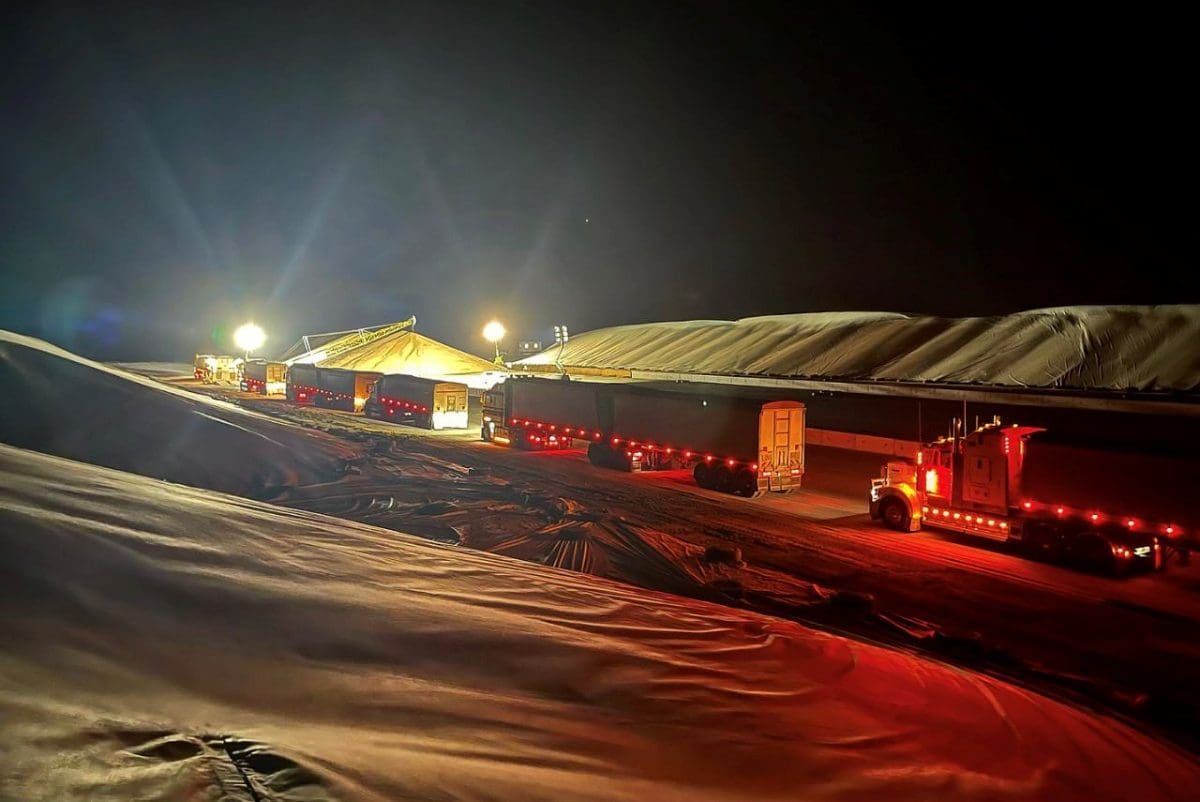
Trucks deliver grain to CHS Broadbent’s Lakaput site in south-west Victoria. Photo: CHS Broadbent
PRICES for feedgrain have steadied in eastern Australian markets this week amid thin buying from domestic consumers who are weighing up their many options for ration mixes for coming months.
In the north, a bumper sorghum harvest and a big corn crop are being considered as inputs, while central and southern markets are looking at barley versus off-spec wheat, both of which are in ample supply.
Solid global demand for wheat and barley appears to have put a floor in the market at prices most growers are prepared to hit with only modest amounts as they quantify the quality of what for many was a weather-affected harvest.
| Nearby | Change from Dec 16 | |
| Barley Downs | $290 | Down $7 |
| SFW wheat Downs | $308 | Down $14 |
| Sorghum Downs | $325 | Down $15 |
| Barley Melbourne | $310 | Up $10 |
| ASW wheat Melbourne | $380 | Down $10 |
| SFW wheat Melbourne | $340 | Up $5 |
Table 1: Indicative delivered prices in Australian dollars per tonne.
North sits on coverage
Northern New South Wales and southern Queensland are about to harvest their biggest sorghum crop in years, and China is expected to be the home for much of it.
In the domestic market, the red grain is a preferred input for some poultry and piggery operations, and could also wriggle its way into feedlot rations if the price drops further.
Norco commodity trader Simon McDougall said the northern consumer is feeling comfortable in the knowledge that plenty of winter crop is in the bin, and a big summer crop is coming.
“I’d say the market’s largely flat, and the consumers aren’t under any pressure to buy,” Mr McDougall said.
“My feeling is the feedlots and the poultry sector have covered January and a reasonable amount of February.”
Mr McDougall said consumers were not keen to buy rain-affected wheat of low test weight, but SFW with its minimum test weight of 70 kilograms per hectolitre appeared to be finding plenty of domestic homes.
However, the lighter-weight GP1 and FED segregations were not so popular.
“Dairy wants quality to offset all that forage they have at the moment, so there’s a drive to corn for that reason, and we should be seeing it by the end of February.”
New-crop corn is currently priced at around $330/t on-farm Moree, and $300/t on the Liverpool Plains.
“On the Downs, there’s a bit of a premium for early sorghum and we’re seeing the first of that now, but it drops back to $300-$305 once we get into March-April,” one trader said.
Growers across southern Queensland appear to be selling barley stored on-farm to make room for incoming sorghum, but hanging on to high-protein wheat which is firming in price.
“Logistics is going to be difficult for sorghum.
“It all wants to price into port, but if we can’t get enough trucks to get it there it will go into the depots if the grower can’t store it all, and we might find some of it working into the domestic market.”
He said some feedlots and other consumers were buying off-grade wheat as an attractive option to barley, which is still readily available in southern Queensland for the time being.
COVID-19 cases are ballooning in Queensland, and sources said this may impact the sorghum supply chain in the near term if enough workers are laid up with the virus.
ASW fits export bill
Quality from the Victorian grain harvest which is now nearing completion has been much higher than that in NSW, where successive rain events sparked sprouting throughout much of the state’s wheat crop.
GeoCommodities broker Brad Knight said a number of wheat crops in Victoria have some distorted grain caused by spring frost, some green grain caused by growth after rain late in the growing season, and some minor staining caused by showers at harvest.
However, low falling numbers as seen in much of the NSW crop have not been a problem, and Victoria’s ports are therefore doing much of the heavy lifting in terms of eastern Australia’s milling wheat exports.
“In Victoria, the quality overall has been great.”
It means Victoria’s ASW and higher grades are pricing into export, and ASW’s spread to barley is relatively high because ASW is in such short supply in NSW.
“Everyone’s still grappling with the feed wheat-to-feed barley spreads, and playing around with what can go into rations at what price.
“The domestic market is still in a state of flux.”
Mr Knight said bids for feed wheat were being chased by growers as they looked to ascertain the value of the grain they have stored on farm, but offers were few and far between so far.
